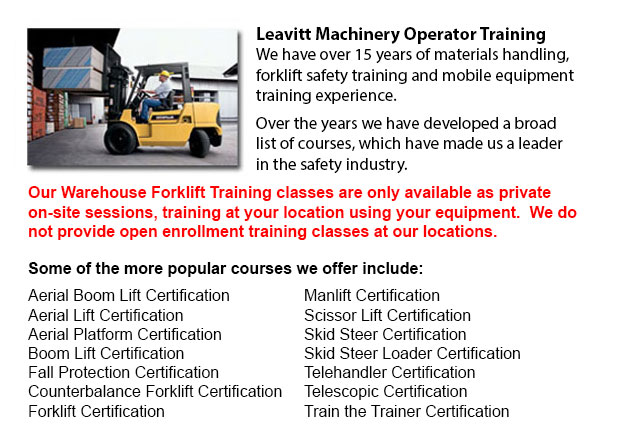
Oshawa Warehouse Forklift Training Programs - Warehouses can be commercial, retail or industrial facilities. Their function could vary from product distribution to retailing bulk products. Regardless of the kind of warehouse, workers inside warehouse settings should be well trained in safety measures related to material storage and handling, loading docks, conveyor systems, and pallet jacks and forklifts. Good housekeeping is essential to a safe and orderly warehouse setting.
Truck and loading dock systems are usually located at a height from the ground. Products enter and exit warehouses through these systems where staff unload and load materials from ramps and elevated docks. Particular attention must be paid to safety practice in this stage. To avoid falls, install yellow striping along the edge of docks and ramps. Pay attention to the area around delivery trucks that are parked at the loading dock, especially the part between dock and the truck. Be certain that truck wheels are chocked when unloading.
Some warehouses make use of conveyor systems to distribute products in the facility. Conveyor systems have moving wheels and belts that pose a pinch point hazard. Keep hair and parts of the body well away from conveyors to prevent injury. Elevated conveyors pose a hazard to personnel under if safety nets are absent. Employees have to know how to stop conveyors in case of emergency. Be aware of the location of emergency stop buttons and off switches. When servicing conveyors, tag out/lock out measures are mandatory.
In order to make it easier to transport supplies, forklifts are pallet jacks are most commonly used. The operator of the lift truck will require training and certification. Pallet jack operators do not need certification, but should be trained on the machinery. Training programs instruct operators in the right methods for lifting materials and transporting them to their assigned location. Neither forklifts nor pallet jacks should ever be made use of to lift or transport employees.
To allow for sufficient room for machinery and individuals to pass, storage shelving and rack systems help to create an efficient and orderly work space, particularly if they are properly braced. Slow and careful placement of good is needed to avoid accidents caused by products falling off the facing aisle. Aisles should be kept clear by storing products flat and in the shelving units. Pallets are utilized for stacking products. They must be in good condition, and palleted products must be shrink-wrapped or baled, whenever possible.
Personal protective equipment (or likewise known as PPE) must be worn, as appropriate, to protect workers' limbs, heads, hands and feet. Bump caps or hard hats, gloves and steel-toed shoes are common PPE.
Slippery floors which are pocked with pits and dents could present significant dangers, making good housekeeping very important. Warehouse docks and floors must be clear of debris oil and dirt. The area must be kept clear of baling materials, trash and boxes.
-
Oshawa Scissor Lift Operator Certification
Oshawa Scissor Lift Operator Certification - North American regulators recommend that worksites need operators of scissor lifts, booms or aerial work platforms to obtain certification training. Scissor lift operator certification is not mandatory, bu... More -
Narrow Aisle Forklift / Order Picker Training / Electric Pallet Jack / Electric Pallet Truck Training in Oshawa
A pallet lift is a model of equipment dedicated in the moving of pallets of many dimensions and weights. They might be utilized as an appendage for platform lifts, cranes and other types of heavy machinery or be applied on their own. Pallet hoists ar... More -
Oshawa Crane Operator Certification
Oshawa Crane Operator Certification - The process to permit people to be able to operate certain kinds of cranes is to take crane operator certification training to get certification. The certification process incorporates classroom learning, hands-o... More -
Oshawa Aerial Platform Training
Oshawa Aerial Platform Training - Aerial platform lifts might be utilized to accomplish a lot of unique tasks executed in hard to reach aerial places. A few of the odd jobs associated with this style of lift include performing routine repair on build... More -
Oshawa Forklift Certification Schools
Oshawa Forklift Certification Schools - Forklift Certification is mandatory within North America. Hence, forklift training programs are important both for companies and for people seeking jobs in industries as forklift operators. Forklift training fo... More -
Oshawa Heavy Equipment Ticket
Oshawa Heavy Equipment Ticket - Depending on the nature of the job at hand, the type of construction equipment that a heavy equipment operator makes use of varies. Each and every type of machine is built to perform specific jobs in the most effective... More -
Oshawa Heavy Equipment Certification
Oshawa Heavy Equipment Certification - Large pieces of machines and heavy-duty vehicles are usually known as heavy equipment. This broad term includes utility vehicles from forestry and agricultural implements to civil engineering vehicles, construct... More -
Oshawa Overhead Crane Safety Training
Oshawa Overhead Crane Safety Training - The overhead crane safety training program is meant to equip the operators with the right skills and knowledge in the areas of: crane safety precautions, accident avoidance, materials handling, and equipment an... More

Forklift Certification Oshawa
TOLL FREE: 1-888-254-6157
Oshawa, Ontario
forkliftcertificationoshawa.com
Email Us
About Us


